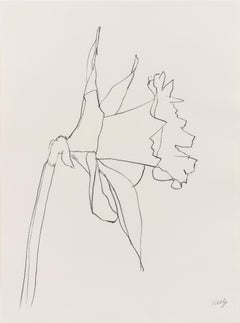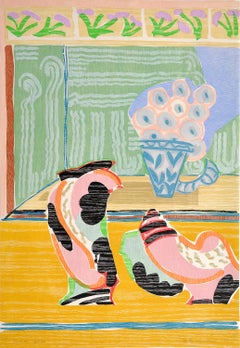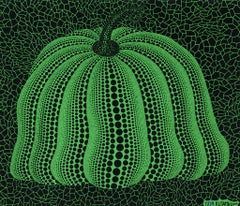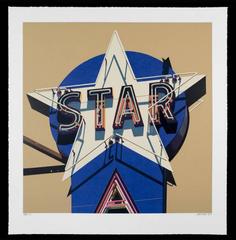Early 2000s Still-life Prints
1
to
11
101
17
33
18
75
39
8
32
23
42
22
4
Overall Height
to
Overall Width
to
77
9
5
4
4
2
2
1
1
26
25
21
17
14
13
10
10
10
7
7
6
5
4
4
4
4
4
3
3
202
192
1,871
1,953
13
14
26
23
45
143
241
419
394
220
170
18
10
6
6
3
28
27
19
19
19
Period: Early 2000s
Your Space on Building
By Ed Ruscha
Located in Palo Alto, CA
Created in 2006, this etching and aquatint on wove paper is hand-signed by Edward Ruscha (1937, Nebraska - ) in pencil in the lower right margin and is numbered from the edition of 3...
Category
Contemporary Early 2000s Still-life Prints
Materials
Aquatint, Etching
Trim Fit (Deconstructed Singer machine gives both steel and silk equal weight)
By Carol Wax
Located in New Orleans, LA
Carol Wax deconstructs a Singer sewing machine in this mezzotint created in an edition of 75. The image gives equal weight to the steel of the machine and the silk of the fabric. It...
Category
American Modern Early 2000s Still-life Prints
Materials
Mezzotint
Daffodil
Located in New York, NY
Frame size: 39 3/4 x 31 1/4 inches
Printer and Publisher: Gemini G.E.L., Los Angeles
Signed and numbered in pencil, lower margin
Category
Early 2000s Still-life Prints
Materials
Lithograph
Kabuki Space by Betty Woodman (INV# NP3629)
Located in Morton Grove, IL
Kabuki Space (INV# NP3629)
Betty Woodman
color woodcut
37 x 25”
# P.P. 2/2, outside the edition of 30
2000
signed
Betty Woodman (1930 - 2018) was a leading American ceramist whose dazzling inventions with form and color have moved beyond the traditional domain of craft and consistently challenged the limits of the medium.
Betty Woodman first became interested in crafts because her father was a woodworker. In high school, one ceramics course was sufficient to convince Woodman that she wanted to be a functional potter. Studying pottery at the School for American Craftsmen at Alfred University, she developed a strong interest in the history of ceramics. Her first job after graduating in 1950 was as a production potter, and that technical facility and experience were to be the foundation of her subsequent innovations. In 1952 Woodman traveled to Italy, where exposure to traditions such as majolica opened her eyes to the potential of clay.
It was not until the seventies that Woodman completely abandoned her functional approach. Collaborating with important figures in the Pattern and Decoration movement, such as Joyce Kozloff and Cynthia Carlson...
Category
Contemporary Early 2000s Still-life Prints
Materials
Woodcut
Pumpkin 2000 (Green)
By Yayoi Kusama
Located in New York, NY
2000
Screenprint in colors, on wove paper
Sheet: 18 1/4 x 24 in.
Edition of 100
Signed, titled, dated, and numbered in pencil, lower margin
Category
Pop Art Early 2000s Still-life Prints
Materials
Screen, Paper
Star, from American Signs Portfolio
Located in New York, NY
ROBERT COTTINGHAM
Star, from American Signs portfolio, 2009
screenprint in colors, on wove paper, with full margins,
40 1/8 x 39 1/8 in (101.9 x 99.4 cm)
signed, dated `2009' and numbered edition of 100 in pencil
--
Robert Cottingham
B. 1935, BROOKLYN, NEW YORK
Born in 1935 in Brooklyn, Robert Cottingham is known for his paintings and prints of urban American landscapes, particularly building facades, neon signs, movie marquees, and shop fronts. After serving in the U.S. Army from 1955 through 1958, he earned a BFA at Pratt Institute, Brooklyn, in 1963. Cottingham began his professional artistic career as an art director for the advertising firm Young and Rubicam in the early 1960s. Although he is typically associated with Photorealism, Cottingham never considered himself a Photorealist, but rather a realist painter working in a long tradition of American vernacular scenes. In this respect, his work often draws parallels to a number of American painters such as Stuart Davis, Charles Demuth, Edward Hopper, and Charles Sheeler.
Cottingham’s interest in the intersections of art and commerce derive from his career as an adman and the influence of Pop art. Many of his paintings convey an interest in typography and lettering, as well as an awareness of the psychological impact of certain isolated words and letters. In his facades, techniques from advertising, namely cropping and enlarging, often produce words of enigmatic or comical resonance such as “Art,” “Ha,” or “Oh.” Cottingham’s enlarged sense of scale is reminiscent of James Rosenquist’s work, while his interest in text suggests the influence of Robert Indiana and Jasper Johns. In general, Cottingham viewed his work as continuing the legacy of Pop artists such as Andy Warhol, who also had a background in advertising.
In 1964, Cottingham relocated to Los Angeles for work. There, inspired by the drastically different environment of the West Coast metropolis, he began to commit seriously to painting. Fascinated by Hollywood’s exaggerated glitz and the downtrodden atmosphere of the downtown, Cottingham saw in Los Angeles the relics of a bygone commercial heyday and desired to capture its kitschy and uncanny atmosphere, bathed in the near perpetual sunlight of Southern California.
In 1968, Cottingham ended his advertising career in order to devote all his time to painting. In the late 1960s, he started using photography in his practice, first as an initial reference point for his process. After selecting a photograph, he translates it into black-and-white drawings by projecting the image onto gridded paper...
Category
Photorealist Early 2000s Still-life Prints
Materials
Screen
American Signs portfolio
Located in New York, NY
ROBERT COTTINGHAM
American Signs portfolio, 2009
The complete set of twelve screenprints in colors, on wove paper, with full margins, 40 1/8 x 39 1/8 in (101.9 x 99.4 cm)
all signed, dated `2009' and numbered edition of 100 in pencil, published by Exhibit A Fine Art and Editions and American Images Atelier, New York, all in excellent condition, contained in original gray silk-covered box with artist and title embossed with gold foil.
Robert Cottingham
B. 1935, BROOKLYN, NEW YORK
Born in 1935 in Brooklyn, Robert Cottingham is known for his paintings and prints of urban American landscapes, particularly building facades, neon signs, movie marquees, and shop fronts. After serving in the U.S. Army from 1955 through 1958, he earned a BFA at Pratt Institute, Brooklyn, in 1963. Cottingham began his professional artistic career as an art director for the advertising firm Young and Rubicam in the early 1960s. Although he is typically associated with Photorealism, Cottingham never considered himself a Photorealist, but rather a realist painter working in a long tradition of American vernacular scenes. In this respect, his work often draws parallels to a number of American painters such as Stuart Davis, Charles Demuth, Edward Hopper, and Charles Sheeler.
Cottingham’s interest in the intersections of art and commerce derive from his career as an adman and the influence of Pop art. Many of his paintings convey an interest in typography and lettering, as well as an awareness of the psychological impact of certain isolated words and letters. In his facades, techniques from advertising, namely cropping and enlarging, often produce words of enigmatic or comical resonance such as “Art,” “Ha,” or “Oh.” Cottingham’s enlarged sense of scale is reminiscent of James Rosenquist’s work, while his interest in text suggests the influence of Robert Indiana and Jasper Johns. In general, Cottingham viewed his work as continuing the legacy of Pop artists such as Andy Warhol, who also had a background in advertising.
In 1964, Cottingham relocated to Los Angeles for work. There, inspired by the drastically different environment of the West Coast metropolis, he began to commit seriously to painting. Fascinated by Hollywood’s exaggerated glitz and the downtrodden atmosphere of the downtown, Cottingham saw in Los Angeles the relics of a bygone commercial heyday and desired to capture its kitschy and uncanny atmosphere, bathed in the near perpetual sunlight of Southern California.
In 1968, Cottingham ended his advertising career in order to devote all his time to painting. In the late 1960s, he started using photography in his practice, first as an initial reference point for his process. After selecting a photograph, he translates it into black-and-white drawings by projecting the image onto gridded paper...
Category
American Realist Early 2000s Still-life Prints
Materials
Screen
Recently Viewed
View AllMore Ways To Browse
James M Smith
Miniature Churches
Monhegan Island Painting
Nancy Reagan
Native American Ceremonial
New Mexico Landscape Sunset
Oil Painting Murphy
Peter Salter
Warship Art
African Male Figure
Autumn Robert Painting
Beach Wooden Sculpture
Dior Tiger
J L George Company
Japanese Black And White Woodblock Prints
Jesus Cross Painting
John Welsh
Judaica Objects





